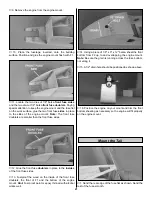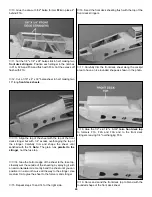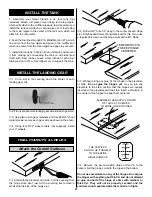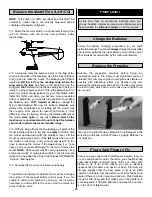
Radio control
1.
I will have completed a successful radio equipment ground
check before the first flight of a new or repaired model.
2.
I will not fly my model aircraft in the presence of
spectators until I become a qualified flier, unless assisted by
an experienced helper.
3.
I will perform my initial turn after takeoff away from the
pit or spectator areas and I will not thereafter fly over pit or
spectator areas, unless beyond my control.
4.
I will operate my model using only radio control
frequencies currently allowed by the Federal
Communications Commission.
The SlowPoke does not possess the self-recovery
characteristics of a primary R/C trainer and should only be
flown by experienced RC pilots. Have fun!
Takeoff on “high” rates if you have dual rates on your
transmitter. For all models it is good practice to gain as
much speed as the length of the runway will permit before
lifting off. This will give you a safety margin in case the
engine quits. When you initially advance the throttle and the
tail begins to lift, the SlowPoke will begin to turn to the left
(due to the torque of the engine–a characteristic of all
taildraggers). Be prepared for this by applying sufficient
right rudder to keep the SlowPoke running straight down
the middle of the runway (or flying field). The left turning
tendency will decrease as the plane picks up speed. Be
sure to allow the tail to rise off the ground before lifting the
model into the air. Depending on the surface you are taking
off from, you will need to apply little or no up elevator until
flying speed is reached. Don’t hold the tail on the ground
with too much up elevator, as the SlowPoke will become
airborne prematurely and may stall. When the plane has
gained enough flying speed to safely lift off, gradually and
smoothly apply up elevator and allow the model to climb at
a shallow angle (do not yank the model off the ground into
a steep climb!)
We recommend that you take it easy with your SlowPoke
for the first several flights, gradually “getting acquainted”
with this Sunday flier as your engine gets fully broken-in. If
you feel as though you have your hands full, keep this one
thing in mind: pull back on the throttle stick to slow the
model down. This will make everything happen a little
slower and allow yourself time to think and react. Add and
practice one maneuver at a time, learning how the
SlowPoke behaves in each. The high rates are primarily for
take offs and landings. For smooth flying and normal
maneuvers, use the low rate settings as listed on page 28.
Sometime well before it’s time to land you should climb your
SlowPoke to a safe altitude and cut the throttle to an idle
and check out the model’s low speed characteristics. Do
this a few times so you know what to expect upon landing.
When it’s time to land, fly a normal landing pattern and
approach. Keep a few clicks of power on until you are over the
runway threshold. For the first few landings, plan to land
slightly faster than stall speed and on the main wheels, as this
is the easiest way to land your SlowPoke. Later, with a little
practice you will find you can make slow 3-point landings.
Have a ball! But always remember to think about your
next move and plan each maneuver before you do it.
Impulsively “jamming the sticks” without any thought
is what gets most fliers in trouble rather than lack of
flying skill.
Landing
Flight
Takeoff
CAUTION (THIS APPLIES TO ALL R/C AIRPLANES): If,
while flying, you notice any unusual sounds, such as a
low-pitched “buzz”, this may indicate control surface
“flutter”. Because flutter can quickly destroy components
of the airplane, any time you detect flutter you must
immediately cut the throttle and land the airplane! Check
all servo grommets for deterioration (this may indicate
which surface fluttered) and make sure all pushrod
linkages are slop-free. If it fluttered once, it will probably
flutter again under similar circumstances unless you can
eliminate the slop or flexing in the linkages. Here are
some things which can result in flutter: Excessive hinge
gap; Not mounting control horns solidly; Sloppy fit of
clevis pin in horn; Elasticity present in flexible plastic
pushrods; Side-play of pushrod in guide tube caused by
tight bends; Sloppy fit of Z-bend in servo arm; Insufficient
glue used when gluing in the elevator joiner wire or
aileron torque rod; Excessive flexing of aileron, caused by
using too soft balsa; Excessive “play” or “backlash” in
servo gears; and Insecure servo mounting.
FLYING
31
Содержание SlowPoke
Страница 6: ...6 DIE CUT PATTERNS...
Страница 32: ...TWO VIEW...


































